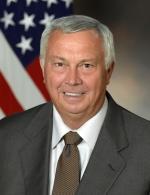US Army Transformation Update
- Transforming requires a value proposition, and our value proposition is to increase and maximize our combat readiness. As we transform, our warfighting units were transforming to smaller, more mobile, more adaptive units business. How do we prepare our people to be able to support that expanded role?
Speaker A is Michael Kirby: We are going to talk to you about the synergies between Lean Six Sigma, other business transformation tools, other business principles and ro. And Steve's going to sort o...
Transcript of the presentation video
NOTE: This transcript of the video was created by AI to enable Google's crawlers to search the video content. It may be expected to be only 96% accurate.
Speaker A is Michael Kirby: We are going to talk to you about the synergies between Lean Six Sigma, other business transformation tools, other business principles and ro. And Steve's going to sort of handle the theory and the ro, and I'm going to handle the other things. But I want to characterize the Pentagon for you, and I want to read a historical quote, not as old as the Bible, but almost from the Pentagon is a mystical animal. If you cut off its tentacles, it grows more. We've wounded it. But the great thing lies there, mad about it, biting its time, waiting for a chance to get its grip on everything again in its suffocating, bureaucratic way with the objective of stifling all action. We've got a big business transformation ro engagement going, but we have an enormous bureaucracy that we're fighting. This was written in 1973 by Chief of Staff of the Army, General Creighton Abrams, who really, after the the Vietnam War, reengineered the business structure of the army the last time it was done. And this is just as true today as it was in 1973. So our objective in the army is to apply proven business principles to these business challenges. We have to try to knock down this mystical beast with its tentacles. But just to give you some notion of size, this is the army. And that's why Ken can use superlatives like the biggest Lean Six Sigma engagement, the biggest Ro engagement, because we're an enormous enterprise. We're a million and a half people, over $225,000,000,000 worth of budget authority. We're higher on the fortune list now than we were when this slide was done all over the world fighting a war, rebuilding countries, doing things. If you can conceive of it, the US army is doing it. And with an enormous business structure. If you take the army and categorize it in terms of war fighting, which is core business, and war fighting support, which is everything that gets the combat capability to where it needs to be, it's about one third, two thirds. So one third of the army is the tooth and two thirds of the army is the tail. That's the current situation. So you're looking at somewhere between 100 and $125,000,000,000 worth of stuff that we're going after to try to make more effective, more efficient, higher quality, to apply these business principles to get the US taxpayer, our allies and everybody else who relies on the US Army for something their money's worth. This is really a description of the challenge. And everybody needs a burning platform. I came from industry. I'm on a three year appointment in this deputy undersecretary role. I've worked with Steve for a long time, came from the aerospace industry in, you know, we talk about a burning platform for change, and this is the Army's burning platform. Now, this isn't necessarily the case right now. I sort of put this notionally in a worst case, but if you take this relevance line and effectiveness. And you see these anchors that pull the effectiveness down. And if there's a description there like, say, congressional support that can push it up or that can pull it down, this is the worst case. So I guess the bottom line of this chart is the army exists in a very nasty world that's not getting any easier, and it exists with external challenges and it exists with internal challenges, primarily funding challenges. Because like everybody else in a setting, you're always resource constrained. So how do you get us up coming from the business world? And you realize there are two sources of cash in an operation. You can increase sales, or in our case, you can go increase appropriations. And that's one way, and we try to do that, at least get our fair share. Or you can capture some of that cash that's around inside your organization right now and put it to more effective use. And that's where this suite of tools called business transformation tries to pull us up onto the effectiveness line, pull us up in terms of relevance, pull us up to where we can do what we need to do with the resources the American people give us. And that's my challenge, to really change the way we're doing business, to change the way the army is doing business. And requisite organization is a very important part of that, as well as some other tools, which I'll explain and give you some context. But first, I want to turn it over to my friend and colleague Steve to sort of take us through some of the theory and get us to where we are right now in the army.
Speaker B is Stephen Clement Transforming requires a value proposition, and our value proposition is to increase and maximize our combat readiness. Now we're working on the combat support side of the House. So we're trying to transfer as much resources and as many dollars from that side to the warfighting side. And so our value proposition is to make sure that we are as efficient and effective as possible on the warfighting support generating side of the House. Now, you can have a couple of different value propositions. You can be operationally excellent, and this is from the discipline of market leaders. Or you could be a product leader, or you could be customer focused. But according to that book, you can do one or the other, but you can't do all three. And we have chosen in our transformation to focus on operational excellence. Now, operational excellence is not just doing what we do today because at the same time that we have to be effective, our mission has changed. We no longer just fight wars. We now are in stability operations and reconstruction operations. And in the parts of the world we work in failed nation states, there is no stability. There is no security. You cannot send in the Agency for International Development and expect them to rebuild. And so we're finding our mission suite dramatically increasing. The question then is how do we prepare our people to be able to support that expanded role? Because we've got to achieve and maintain competitive capability. No choice. This is not new. Sir Roderick is working with us. And it's interesting, he went through the same notion of transforming Rio Tinto when he was there. And I put a couple of things up there. Rod surveyed the world's best practices. We're looking at best practices in terms of the kinds of business things that we apply. And it was interesting that Rod looked at the army, he looked at the Japanese and the Vietnamese army. The Japanese, because they had some interesting standard ranks or structure. And I'll talk a little bit more about that in a minute. The Okagawa for about 400 years. And the Vietnamese, because they had small units. And you'll see, as we transform, our warfighting units were transforming to smaller, more mobile, more adaptive units business. For those of you who are consultants in there, rod didn't see a whole lot out there when he was looking at this back in the 80s. He did look at Toyota and saw some interesting things. And then he reviewed all these books and he only found one book that he thought was worthwhile and only one page on that one book. And that was an interesting page on General theory, page 173. Now, and I want you all to go out and look at that damn page, because what he saw on that page was not what was on that page. Okay? Well, there's a couple several ways path you can take to become operationally excellent. You can do the lazy path, you can do nothing. Put the head in the sand and just hope it goes away. Or you can not be very bright and just say, I'm going to do a salami slice. And we routinely do that. Everybody loses 10%, irrespective of whether or not you need to lose 10%, because that's easy just across the board. Or you can take a smart path, which is the path we've tried to take. And that's to analyze the organization, restructure the organization, then look at introducing continuous process improvement tools, be situationally aware in terms of best practices and get the boss to drive the change process. And we heard some of those things mentioned this morning in terms of the boss being behind the change process. Senior leaders work is to change it. And you'll see in a minute. We've tried to define that. Okay, the integrating challenge that Mike has is very simple. Elliot was very, very good vertically. Nobody else knew structure like he did. Deming knows quality and new quality. And womack knew lean six. Toyota put it all together into the Toyota production system and they kept it proprietary for a long time. Not surprising that they're the number one manufacturing operation in the world because they were able to pull all those things in together. Your challenge is to take the ideas and put those into a system very similar to that. What we're trying to do is we are trying to introduce into our school system and our educational process us the equivalent of the Toyota production system. We're calling it probably the managerial leadership system. We're introducing a new management system and we're using proven principles and it's probably going to take us five or more years to grow the next generation.
Major organizations and consulting firms that provide Requisite Organization-based services






